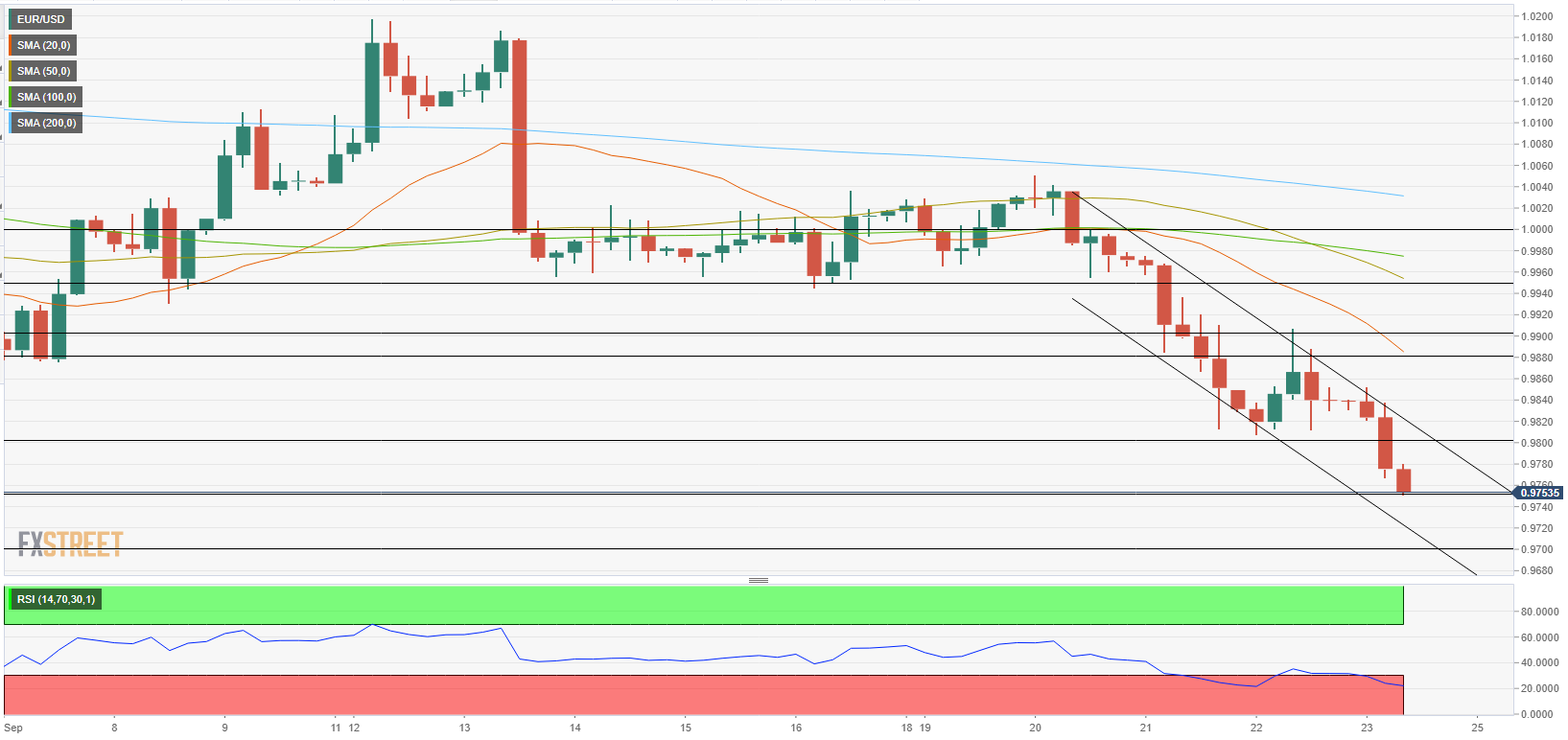- EUR/USD slumped to a fresh two-decade low below 0.9800.
- Disappointing PMI data weigh on the shared currency ahead of the weekend.
- The greenback could preserve its strength amid risk aversion.
Following Thursday's unconvincing recovery attempt, EUR/USD has turned south and dropped to its weakest level in two decades below 0.9800. The pair closes in on 0.9750, which aligns as the next line of defence, and the risk-averse market environment suggests that the shared currency is likely to stay on the backfoot.
Earlier in the day, the data from the euro area revived concerns over a deep recession and forced the euro to deal with additional selling pressure. S&P Global's Composite PMI for Germany declined to 45.9 from 46.9 in August and dropped to 48.2 from 48.9 for the eurozone, revealing that the economic activity in the private sector continued to contract at a strengthening pace.
Commenting on the PMI surveys, "a eurozone recession is on the cards as companies report worsening business conditions and intensifying price pressures linked to soaring energy costs," said Chris Williamson, Chief Business Economist at S&P Global Market Intelligence. "The challenge facing policymakers of taming inflation while avoiding a hard landing for the economy is therefore becoming increasingly difficult.”
In the second half of the day, S&P will release the preliminary PMI figures for the US as well. A recovery in the service sector's activity could help the dollar continue to outperform its rivals ahead of the weekend. Meanwhile, US stock index futures are losing between 0.5% and 0.7%, suggesting that safe-haven flows are likely to dominate the financial markets during the American trading hours.
It's worth mentioning, however, profit-taking toward the end of the European session could ramp up the volatility and help the shared currency limit its losses in the short term.
EUR/USD Technical Analysis
EUR/USD is trading within a touching distance of 0.9750 (static level). With a four-hour close below that level, additional losses toward 0.9700 and 0.9660 (August 2002 low) could be witnessed.
On the four-hour chart, the Relative Strength Index (RSI) indicator stays well below 30, suggesting that the pair could make a technical correction before the next leg lower. In that case, 0.9800 (static level, former support) could be seen as first hurdle before 0.9880 (static level, 20-period SMA) and 0.9900 (psychological level).
Information on these pages contains forward-looking statements that involve risks and uncertainties. Markets and instruments profiled on this page are for informational purposes only and should not in any way come across as a recommendation to buy or sell in these assets. You should do your own thorough research before making any investment decisions. FXStreet does not in any way guarantee that this information is free from mistakes, errors, or material misstatements. It also does not guarantee that this information is of a timely nature. Investing in Open Markets involves a great deal of risk, including the loss of all or a portion of your investment, as well as emotional distress. All risks, losses and costs associated with investing, including total loss of principal, are your responsibility. The views and opinions expressed in this article are those of the authors and do not necessarily reflect the official policy or position of FXStreet nor its advertisers. The author will not be held responsible for information that is found at the end of links posted on this page.
If not otherwise explicitly mentioned in the body of the article, at the time of writing, the author has no position in any stock mentioned in this article and no business relationship with any company mentioned. The author has not received compensation for writing this article, other than from FXStreet.
FXStreet and the author do not provide personalized recommendations. The author makes no representations as to the accuracy, completeness, or suitability of this information. FXStreet and the author will not be liable for any errors, omissions or any losses, injuries or damages arising from this information and its display or use. Errors and omissions excepted.
The author and FXStreet are not registered investment advisors and nothing in this article is intended to be investment advice.
Recommended Content
Editors’ Picks
USD/JPY jumps above 156.00 on BoJ's steady policy

USD/JPY has come under intense buying pressure, surging past 156.00 after the Bank of Japan kept the key rate unchanged but tweaked its policy statement. The BoJ maintained its fiscal year 2024 and 2025 inflation forecast, disappointing the Japanese Yen buyers.
AUD/USD consolidates gains above 0.6500 after Australian PPI data

AUD/USD is consolidating gains above 0.6500 in Asian trading on Friday. The pair capitalizes on an annual increase in Australian PPI data. Meanwhile, a softer US Dollar and improving market mood also underpin the Aussie ahead of the US PCE inflation data.
Gold price keeps its range around $2,330, awaits US PCE data

Gold price is consolidating Thursday's rebound early Friday. Gold price jumped after US GDP figures for the first quarter of 2024 missed estimates, increasing speculation that the Fed could lower borrowing costs. Focus shifts to US PCE inflation on Friday.
Stripe looks to bring back crypto payments as stablecoin market cap hits all-time high

Stripe announced on Thursday that it would add support for USDC stablecoin, as the stablecoin market exploded in March, according to reports by Cryptocompare.
US economy: Slower growth with stronger inflation

The US Dollar strengthened, and stocks fell after statistical data from the US. The focus was on the preliminary estimate of GDP for the first quarter. Annualised quarterly growth came in at just 1.6%, down from the 2.5% and 3.4% previously forecast.
